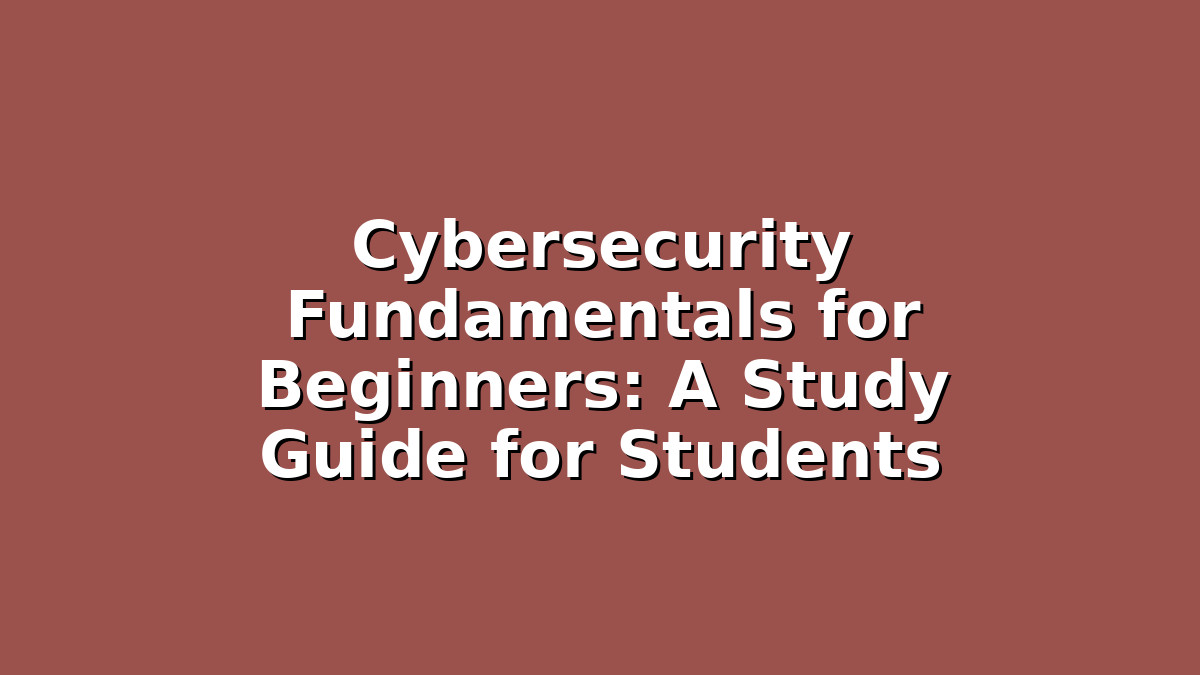In today’s digital age, cybersecurity is more important than ever. Whether you’re a student preparing for exams in computer science, information technology, or simply looking to build a strong foundation in cybersecurity, understanding the basics can set you up for success. Cyber threats are constantly evolving, and having a solid grasp of cybersecurity fundamentals not only helps you protect yourself online but also opens the door to exciting career opportunities. This article will guide you through essential cybersecurity concepts and provide practical study tips to help you master the subject effectively.
1. Understanding the Core Concepts of Cybersecurity
Before diving into complex topics, it’s important to get comfortable with the core concepts that form the backbone of cybersecurity. These include:
– Confidentiality: Ensuring information is only accessible to those authorized to see it.
– Integrity: Keeping data accurate and unaltered unless properly authorized.
– Availability: Making sure systems and data are accessible when needed.
Beyond these, you should also understand the common types of cyber threats such as malware, phishing, ransomware, and social engineering. Familiarize yourself with basic terms like firewalls, encryption, VPNs, and two-factor authentication.
#### Study Tip:
Create flashcards with key terms and definitions. Use tools like Anki or Quizlet to review these regularly. Repetition is crucial for memorizing cybersecurity vocabulary, which can often seem overwhelming at first.
2. Practical Approaches to Learning Cybersecurity
Theory alone won’t prepare you for real-world cybersecurity challenges. Hands-on practice is invaluable. Here’s how to include practical learning in your study routine:
– Set up a Virtual Lab: Use virtualization software like VirtualBox or VMware to create your own safe environment for experimenting with different operating systems and security tools. You can practice installing firewalls, configuring antivirus software, or even testing how malware behaves safely.
– Explore Free Online Platforms: Websites like TryHackMe, Hack The Box, or Cyber Aces offer beginner-friendly cybersecurity labs and challenges. These platforms provide guided exercises that help you apply theoretical knowledge in simulated attack and defense scenarios.
– Follow Structured Courses: Many universities and platforms such as Coursera, edX, and Udemy offer free or affordable cybersecurity courses tailored for beginners. These usually mix video lectures with quizzes and assignments to reinforce learning.
#### Study Tip:
Set goals for hands-on practice by allocating specific times during your week solely for lab work or interactive challenges. Treat these sessions like mini-exams to simulate pressure and improve focus.
3. Study Strategies to Retain and Understand Cybersecurity Material
Cybersecurity covers a wide range of topics, which can be tough to absorb all at once. Effective study strategies can make a significant difference in your understanding and retention:
– Break Down Complex Topics: Instead of trying to learn everything in one go, divide subjects like networking, cryptography, or ethical hacking into smaller, manageable parts. For example, focus on TCP/IP basics before moving to network security protocols.
– Use Visual Aids: Diagrams, flowcharts, and mind maps help you visualize how different components interact in a network or how an attack progresses. Tools like draw.io or MindMeister can assist in creating your own study visuals.
– Teach What You Learn: Explain cybersecurity concepts to a friend or study group. Teaching forces you to articulate your understanding clearly and reveals any gaps in your knowledge.
– Practice Past Exam Questions and Quizzes: If you’re preparing for exams, practice questions are an excellent way to test your knowledge and get familiar with the exam format. Many textbooks and online resources provide sample questions and mock tests.
– Stay Updated on Current Cybersecurity News: Reading news about recent data breaches, new security vulnerabilities, or government regulations keeps your knowledge relevant and makes the subject more interesting.
#### Study Tip:
Create a study schedule that includes varied activities—reading, practicing, teaching, and reviewing news—to keep your study sessions engaging and well-rounded.
Conclusion
Mastering cybersecurity fundamentals as a beginner might seem daunting, but with the right approach, it becomes an achievable and rewarding journey. Start by building a strong vocabulary of core concepts, then complement your learning with hands-on practice and structured courses. Use smart study techniques like breaking down topics, visualizing complex ideas, and actively teaching others to deepen your understanding.
Remember, cybersecurity is a dynamic field, and staying curious and proactive is key to success. Don’t be afraid to experiment, ask questions, and seek help when needed. With consistent effort and an eagerness to learn, you can confidently prepare for your exams and lay the groundwork for a bright future in cybersecurity.

Responses